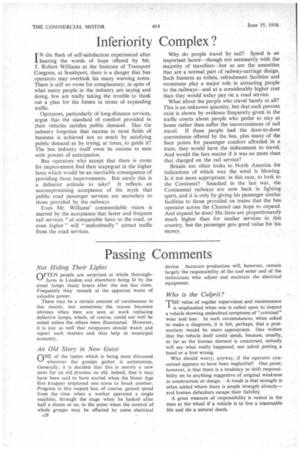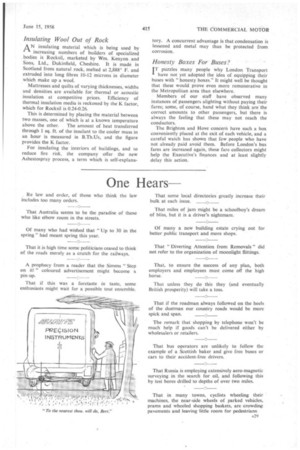Passing Comments
Page 30

Page 31

If you've noticed an error in this article please click here to report it so we can fix it.
Not Hiding Their Lights
OFTEN people are surprised at whole thoroughfares in London and elsewhere being lit by the street lamps many hours after the sun has risen. Frequently they remark at the apparent waste of valuable power.
There may be a certain amount of carelessness in this matter, but sometimes the reason becomes obvious when men are seen at work replacing defective lamps, which, of course, could not well be noted unless the others were illuminated. However, it is just as well that ratepayers should watch and report such matters and thus help in municipal economy.
An Old Story in New Guise
nNE of the topics which is being most discussed
wherever the gossips gather is automation. Generally, it is decided that this is merely a new term for an old Process; so old, indeed, that it may have been said to have started when the Stone Age flint knapper employed one stone to break another. Progress in this respect has, of course, gained speed from the time when a worker operated a single machine, through the stage when he looked after half a dozen or so, to the point when the control of whole groups may be effected by some electrical A28 device. Accurate production will, however, remain largely the responsibility of the tool setter and of the technicians who adjust and maintain the electrical equipment.
Who is the Culprit?
THE value of regular supervision and maintenance is emphasized when one is called upon to inspect a vehicle showing undoubted symptoms of "criminal" wear and tear. In such circumstances, when asked to make a diagnosis, it is felt, perhaps, that a postmortem would be rriore appropriate. One wishes that the vehicle itself could speak, because, usually, so far as the human element is concerned, nobody will say what really happened, nor admit putting a hand or a foot wrong.
Who should worry, anyway, if the operator concerned appears to have been neglectful? One point, however, is that there is a tendency to shift responsibility on to anything suggestive of original weakness in construction or design. A result is that strength is often added where there is ample strength already— and human defaulters escape their liability.
A great measure of responsibility is vested in the man at the wheel if a vehicle is to live a reasonable life and die a natural death.
Insulating Wool Out of Rock
A N insulating material which is being used by " increasing numbers of builders of specialized bodies is Rocksil, marketed by Wm. Kenyon and Sons, Ltd., Dukinfield, Cheshire. It is made in Scotland from natural rock, melted at 2,888° F. and extruded into long fibres 10-12 microns in diameter which make up a wool.
Mattresses and quilts of varying thicknesses, widths and densities are available for thermal or acoustic insulation at competitive prices. Efficiency of thermal insulation media is reckoned by the K factor, which for Rocksil is 0.24-0.26.
This is determined by placing the material between two masses, one of which is at a known temperature above the other. The amount of heat transferred through 1 sq. ft. of the insulant to the cooler mass in an hour is measured in B.Th.Us, and the figure provides the K factor.
For insulating the interiors of buildings, and to reduce fire risk, the company offer the new Asbestospray process, a term which is self-explana
tory. A concurrent advantage is that condensation is lessened and metal may thus be protected from corrosion.
Honesty Boxes For Buses?
IT puzzles many people why London Transport I have not yet adopted the idea of equipping their buses with "honesty boxes." It might well be thought that these would prove even more remunerative in the Metropolitan area than elsewhere.
Members of our staff have observed many instances of passengers alighting without paying their fares; some, of course, hand what they think are the correct amounts to other passengers, but there is always the feeling that these may not reach the conductors.
The Brighton and Hove concern have such a box conveniently placed at the exit of each vehicle, and a careful watch has shown that few people who have not already paid avoid them. Before London's bus fares are increased again, these fare collectors might help the Executive's finances and at least slightly delay this action.




































































































